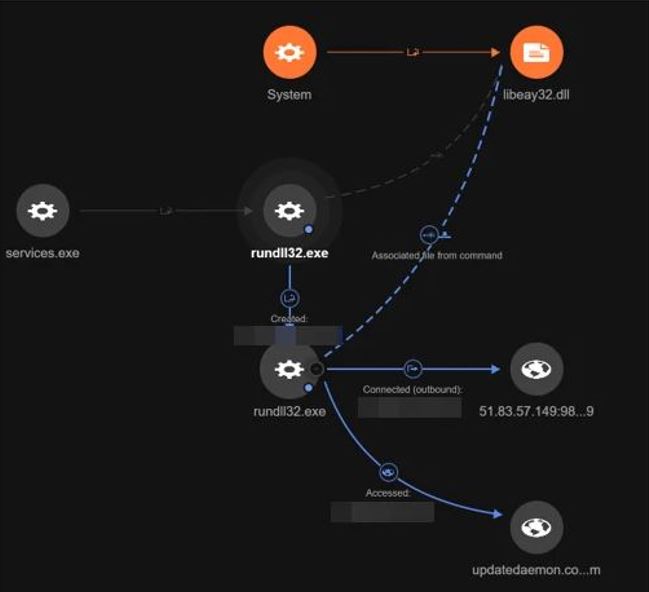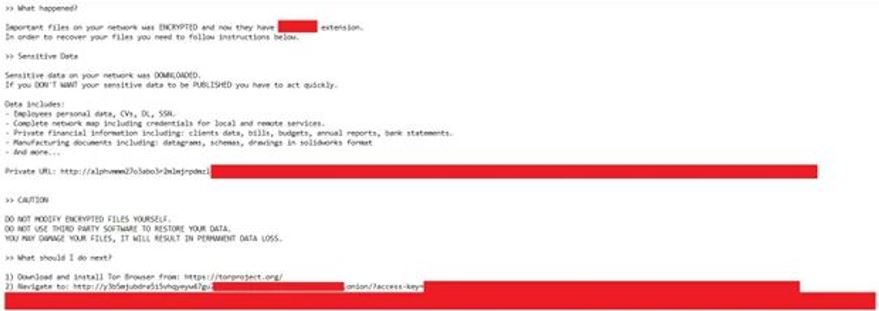BlackCat Ransomware
Original Issue Date:-
September 15, 2022
Virus Type:- Ransomware
Severity:-
Medium
It is reported that the ransomware dubbed as “Blackcat” (also known as AlphaVM or AlphaV), expands its operations via attacking the organizations through exploiting the unpatched vulnerabilities of Microsoft Exchange servers (such as CVE-2021-31207 although patch was issued in May 2021). The ransomware is delivered as ransomware-as-a-service (RaaS) model and dropped in the machine via third party toolset (e.g. Cobalt Strike) and utilizes exploitation of exposed insecure applications of Exchange servers as an entry point to network.
The variants of this malware targets Windows as well as Linux platform. While the malware traversed through victim’s network, information stolen for extortion of the victim.
Infection Mechanism
As observed, initial infection mechanism involves the dropping the malicious web shell scripts on the Microsoft Exchange servers so that arbitrary command could be implemented by the threat actor such as for stealing data and further malware download. Later Cobalt Strike beacon is downloaded.
Further, a Powershell command is used to download a fake DLL file “libeay32.dll” that is tempered version common DLL used by OpenSSL. The exported function of this file is tempered to host a Cobalt Strike stager shellcode. Upon execution, this exported function serves as a loader for a classic Cobalt Strike stager shellcode and invalid certificate of the dll is used.
The stager sends the HTTP GET request to a remote C2 server and payload is downloaded which initiates WerFault.exe process and infuse it into system to host another Cobalt Strike beacon.

The WerFault.exe process perform various activities such as account discovery, dropping and execution of NetScan tool, Bloodhound tool etc. which later perform their designated tasks.
Before execution of ransomware, some suspicious batch file are executed. Threat actors use SysVol Share to host ransomware. A copy of the sample was also stored locally on the C:\Windows\debug folder. Further file permission are also changed. After setting up environment, ransomware is executed which deletes the volume shadow copies to make recovery difficult and increases the server service’s network request capacity for faster encryption, stop IIS service and clearing event logs etc. At next stage, ransomware starts encryption and adds 7-random-digit extension to the encrypted files. Then a ransom note is dropped informing victim about attack and tell them to access the Tor domain regarding ransom payment.

Indicator of Compromise:
C2 Cobalt Strike IP Address:
- 51.83.57[.]149
- 5.255.100[.]242
For more detailed list of IOC (Hashes and detected file names), kindly refer the URL:
- https://www.trendmicro.com/content/dam/trendmicro/global/en/research/22/d/an-investigation-of-the-blackcat-ransomware-via-trend-micro-vision-one/an-investigation-of-the-blackcat-ransomware-via-trend-micro-vision-one-iocs.txt
- https://www.microsoft.com/security/blog/2022/06/13/the-many-lives-of-blackcat-ransomware/
Best Practices and Recommendations:
- Maintain offline backups of data, and regularly maintain backup and restoration. This practice will ensure the organization will not be severely interrupted, have irretrievable data.
- Ensure all backup data is encrypted, immutable (i.e., cannot be altered or deleted) and covers the entire organization’s data infrastructure.
- Implement all accounts with password logins (e.g., service account, admin accounts, and domain admin accounts) to have strong, unique passwords.
- Implement multi-factor authentication for all services to the extent possible, particularly for webmail, virtual private networks, and accounts that access critical systems.
- Remove unnecessary access to administrative shares.
- Use a host-based firewall to only allow connections to administrative shares via server message block (SMB) from a limited set of administrator machines.
- Enable protected files in the Windows Operating System to prevent unauthorized changes to critical files.
- Disable remote Desktop Connections, employ least-privileged accounts. Limit users who can log in using Remote Desktop, set an account lockout policy. Ensure proper RDP logging and configuration.
- Check regularly for the integrity of the information stored in the databases.
- Ensure integrity of the codes /scripts being used in database, authentication and sensitive system.
- Establish Domain-based Message Authentication, Reporting, and Conformance (DMARC), Domain Keys Identified Mail (DKIM) and Sender Policy Framework (SPF) for your domain, which is an email validation system designed to prevent spam by detecting email spoofing by which most of the ransomware samples successfully reaches the corporate email boxes.
- Keep the operating system, third party applications (MS office, browsers, browser Plugins) up-to-date with the latest patches.
- Application white listing/Strict implementation of Software Restriction Policies (SRP) to block binaries running from %APPDATA% and %TEMP% paths. Ransomware sample drops and executes generally from these locations.
- Maintain updated Antivirus software on all systems.
- Don't open attachments in unsolicited e-mails, even if they come from people in your contact list, and never click on a URL contained in an unsolicited e-mail, even if the link seems benign. In cases of genuine URLs close out the e-mail and go to the organization's website directly through browser.
- Follow safe practices when browsing the web. Ensure the web browsers are secured enough with appropriate content controls.
- Network segmentation and segregation into security zones - help protect sensitive information and critical services. Separate administrative network from business processes with physical controls and Virtual Local Area Networks.
- Disable ActiveX content in Microsoft Office applications such as Word, Excel, etc.
- Restrict access using firewalls and allow only to selected remote endpoints, VPN may also be used with dedicated pool for RDP access.
- Use strong authentication protocol, such as Network Level Authentication (NLA) in Windows.
- Additional Security measures that may be considered are:
- Use RDP Gateways for better management.
- Change the listening port for Remote Desktop.
- Tunnel Remote Desktop connections through IPSec or SSH.
- Two-factor authentication may also be considered for highly critical systems.
- If not required consider disabling PowerShell / windows script hosting.
- Restrict users' abilities (permissions) to install and run unwanted software applications.
- Enable personal firewalls on workstations.
- Implement strict External Device (USB drive) usage policy.
- Employ data-at-rest and data-in-transit encryption.
- Consider installing Enhanced Mitigation Experience Toolkit, or similar host-level anti-exploitation tools.
- Block the attachments of file types, exe|pif|tmp|url|vb|vbe|scr|reg|cer|pst|cmd|com|bat|dll|dat|hlp|hta|js|wsf
- Carry out vulnerability Assessment and Penetration Testing (VAPT) and information security audit of critical networks/systems, especially database servers from CERT-IN empanelled auditors. Repeat audits at regular intervals.
- Individuals or organizations are not encouraged to pay the ransom, as this does not guarantee files will be released. Report such instances of fraud to CERT-In and Law Enforcement agencies.
References:
- https://www.bleepingcomputer.com/news/security/microsoft-exchange-servers-hacked-to-deploy-blackcat-ransomware/
- https://www.microsoft.com/security/blog/2022/06/13/the-many-lives-of-blackcat-ransomware/
- https://cve.mitre.org/cgi-bin/cvename.cgi?name=CVE-2021-31207
- https://www.trendmicro.com/en_us/research/22/d/an-investigation-of-the-blackcat-ransomware.html
- https://www.csk.gov.in/alerts/ransomware.html


